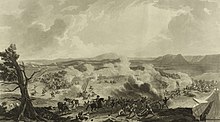Battle of Kirkee
| Battle of Kirkee (modern-day Khadki) | |||||||
|---|---|---|---|---|---|---|---|
| Part of the Third Anglo-Maratha War | |||||||
 |
|||||||
|
|||||||
| Belligerents | |||||||
|
|
|
||||||
| Commanders and leaders | |||||||
| Bapu Gokhale | Lt. Col. Burr, Captain Ford | ||||||
| Strength | |||||||
| 28,000 | 3,000 | ||||||
| Casualties and losses | |||||||
| 500 | 86 | ||||||
The Battle of Khadki,also known as Battle of Kirkee or Ganesh Khind, took place at Khadki, India on November 5, 1817 between the forces of the British East India Company and the Maratha Empire under the leadership of Baji Rao II. Khadki is the name of the populated northern boundary of Pune, created naturally by the encircling Mula River in Maharashtra, India. It later became a military cantonment.
The Third Battle of Panipat,proved disastrous for the Maratha Empire/Confederacy. Maratha Sardars took advantage of the reduced strength and command of Peshwas over Maharashtra and the Maratha Empire started to decline. The Peshwas were in very high debts (taken for battles and governance) and were not receiving any income from taxes (all Sardars were keeping the taxes to themselves instead of sending it to Peshwas). They were not in a good position to fight with British forces. After death of Madhavrao Peshwa, the Maratha empire fell into a state of constant decline.
The Maratha Army consisted of Huzurat or Sarkari Fouz and had the following Generals when the battle began. Marathas: Bapu Gokhale, assisted by Anandrao Babar, Vithalrao Vinchurkar, assisted by Rajwade, Govindrao Ghorpade Mudholkar, Tryambakrao Rethrekar, Shaikh Miraj, Dafle, Bahirji Shitole, Mor Dixit, assisted by Sardar Kokre, Sardar Appa Desai Nipankar, assisted by Sardar Pandhare, Sardar Naropant Apte, Sardar Yashwantrao Ghorpade Sondurkar, Sardar Wamanrao Raaste, Sardar Chintamanrao Patwardhan, assisted by Bapu Narayan Bhave Ramdurgkar, Sardar Mutalik on behalf of Pant Pratinidhi, Sardar Naik Anjurkar, Sardar Purandare, and Sardar Nagarkar, assisted by Moreshwar Kanitkar,Raghoji salve. All these sardars (the equivalent of Earls or Dukes) had both cavalry and infantry. The army's Artillery was led by Laxmanrao Panshe and his nephew.
The East India Company's army was led by Col. Burr, who marched to Kirkee on 1 Nov., and Capt. Ford, who marched towards on 4 Nov.
Bapu Gokhale commanded a total force of 28,000 men (20,000 horse and 8,000 infantry) with 20 guns. The British force numbered only 3,000, of whom 2,000 were cavalry and 1,000 infantry, with 8 guns.
...
Wikipedia
